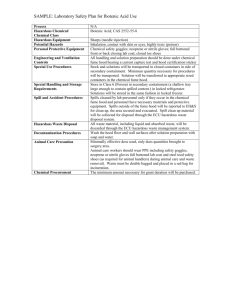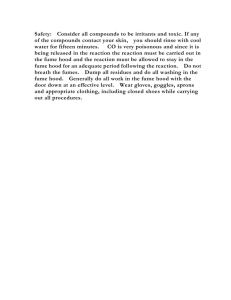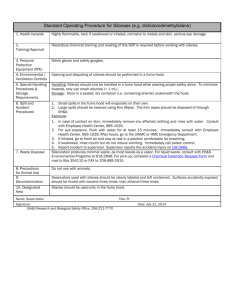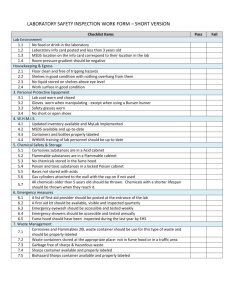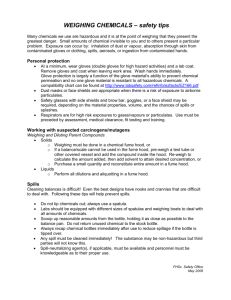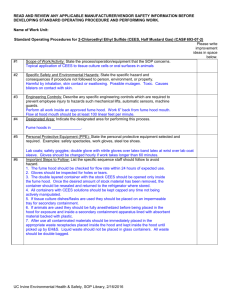California State Polytechnic University, Pomona
advertisement
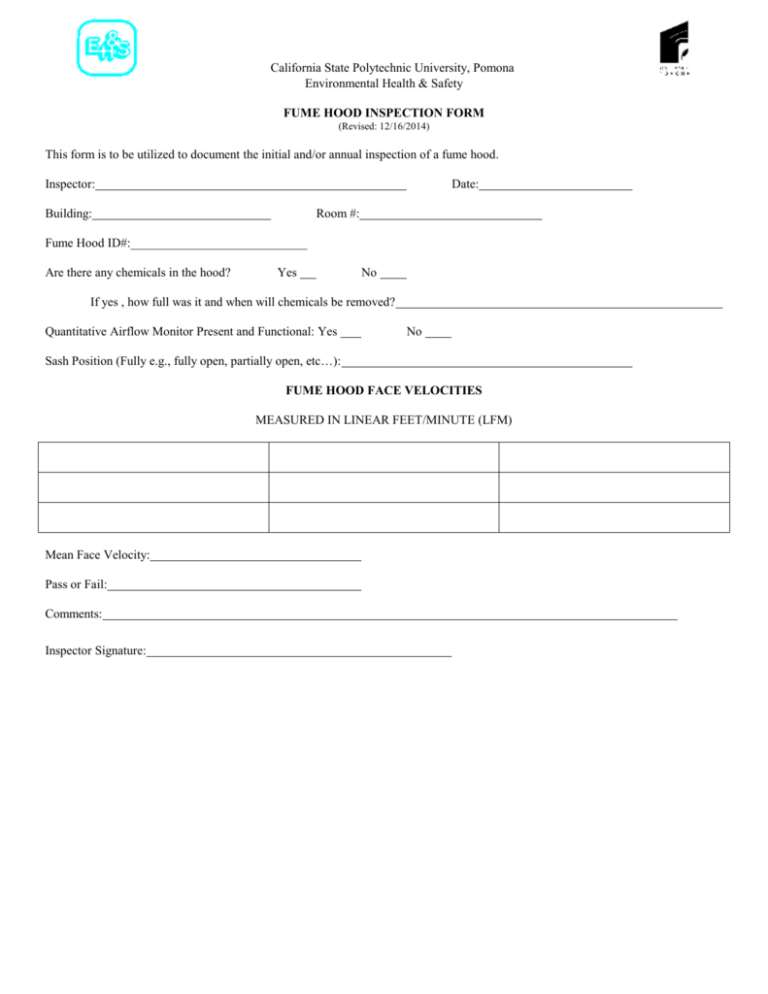
California State Polytechnic University, Pomona Environmental Health & Safety FUME HOOD INSPECTION FORM (Revised: 12/16/2014) This form is to be utilized to document the initial and/or annual inspection of a fume hood. Inspector: Date: Building: Room #: Fume Hood ID#:____________________________ Are there any chemicals in the hood? Yes No If yes , how full was it and when will chemicals be removed? Quantitative Airflow Monitor Present and Functional: Yes No Sash Position (Fully e.g., fully open, partially open, etc…): FUME HOOD FACE VELOCITIES MEASURED IN LINEAR FEET/MINUTE (LFM) Mean Face Velocity: Pass or Fail: Comments: Inspector Signature: Fume Hood Inspection Procedures Materials: Fume Hood Inspection Forms are available at http://www.cpp.edu/~ehs/files/chemical/FumeHoodInspectionForm.doc on the EH&S Web Site. Yellow Tags o Obtain through EH&S located in Building 98, Room B1-35 at Extension 4697 TSI VelociCalc 9535-A Anemometer or Velometer Jr. o Obtain through EH& S located in Building 98, Room B1-35 at Extension 4697 Procedure 1. Completely open the fume hood by positioning the sash to its maximum height. If the sash is separated into three separate panels create the largest opening possible according to the fume hood dimensions. 2. Visually divide the opening into nine squares (three rows by three columns). 3. Check that air in the hood is flowing inward by looking at the direction of the vent ribbon (some fume hoods have digital display that accomplishes this). 4. Measure the velocity of the air at the center of each of the nine squares with the TSI VelociCalc 9535-A Anemometer or Velometer Jr. Using the TSI VelociCalc 9535-A Anemometer: Remove red sensor protection cap. Press the “Power Key” to turn on the meter. To shut down the meter press and hold the “Power Key”. Once the meter powers up it will display the velocity in “ft/min”. This meter will log your readings under a separate Test Number for each fume hood. Before testing each fume hood you should press the “NEXT TEST” Key, the upper left key. o To test a fume hood, hold the probe in the airstream and press the “Enter Key” when you want to store a sample (reading). The meter will beep when you first press the “Enter Key” and then again in about 4 seconds later when it has stored the sample. Repeat for all nine squares. Remember to press the “NEXT TEST” Key before testing the next fume hood. o To retrieve your measurements (logged data), press the “MENU” Key and use the up/down arrow keys to highlight “Data Logging” and press the “Enter Key”. Use the up/down arrow keys to highlight “View Data” and press the “Enter Key”. Use the left/right on screen arrow keys to choose the test number want to view and then use the up/down arrow keys to highlight “View Samples: and press the “Enter Key”. Use the up/down arrow keys to view the velocity for each sample. Pressing the “ESC” key will take you back to the previous screen or all the way to the main screen if you press it multiple times. o To clear (delete) the test and sample data, press the “MENU” Key and use the up/down arrow keys to highlight “Data Logging” and press the “Enter Key”. Use the up/down arrow keys to highlight “Delete Data” and press the “Enter Key”. Use the up/down arrow keys to highlight “Delete All” and press the “Enter Key” then press “Yes” to confirm. Using the Velometer Jr: Turn the left knob to fully clockwise until it stops. This is the low velocity scale, which is 0-200 linear feet. Hold the velometer in the opening of fume hood with the left side pointing out of the hood. When the meter stabilizes take the reading. Repeat for all nine squares. 5. If any of the nine squares do not pass minimum velocity requirement of 70 linear feet per minute, move the sash down or left/right to reduce the size of the opening. Divide the fume hood opening into nine new squares and repeat Step 4. If the first attempt at moving the sash down to meet minimum velocity requirements does not succeed, continue to lower the sash until minimum velocity requirements are met. Note: If the sash is too low (typically 6” opening or less) for normal and safe laboratory procedures, then the fume hood is unsafe and should not be used until modifications or repairs are completed. Fume hoods that do not pass are to be labeled or marked “Do not Use” and if possible locked out until they pass. You may contact Facilities Management at extension 3030 for repairs. There may be a cost for Facilities Management to make the repairs. 6. Once the sash is at a height or position that satisfies the minimum velocity requirements, fill out the hood survey information on the Yellow Tag and stick it on the side of the sash to indicate this height for optimal ventilation. Dating the Yellow Tag is important because a new tag will override any older existing tags. 7. Fill out the Fume Hood Inspection Form and return all completed forms to Environmental Health & Safety (EH&S) in building 98 room B1-102. Determining Whether to Pass a Hood The following conditions must all be met in order for the hood to pass: 1. The average face velocity must be a minimum of 100 feet per minute (fpm). 2. A minimum velocity of 70 fpm at any point. 3. Air is not flowing out of the hood at any point. 4. There is an operational airflow indicator for the fume hood. Example, a vent ribbon or digital display. Please contact EH&S with any questions or concerns (909) 869-4697.

